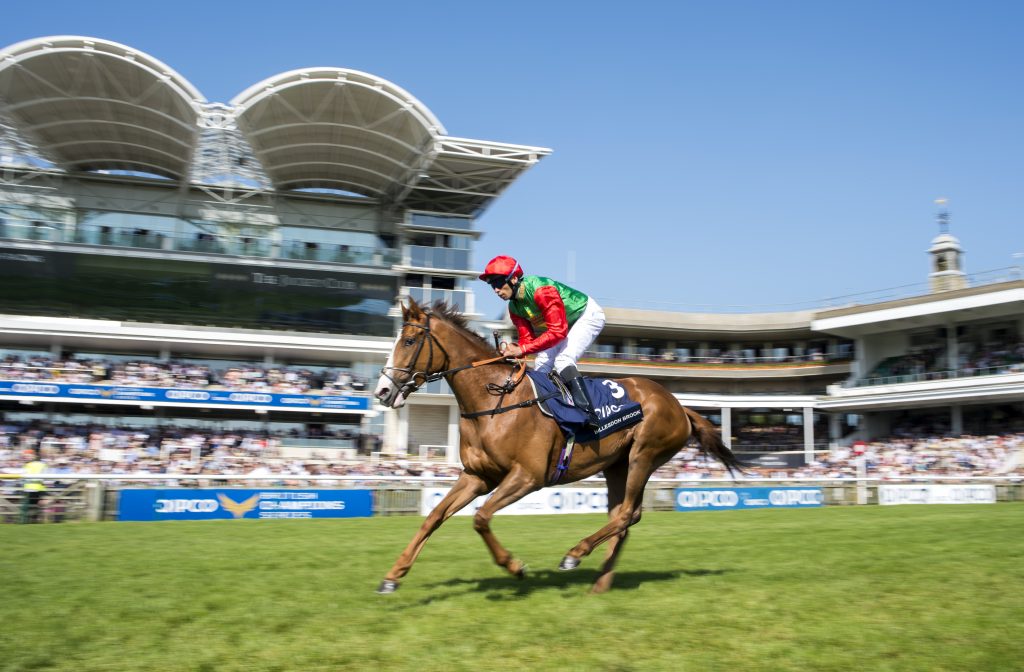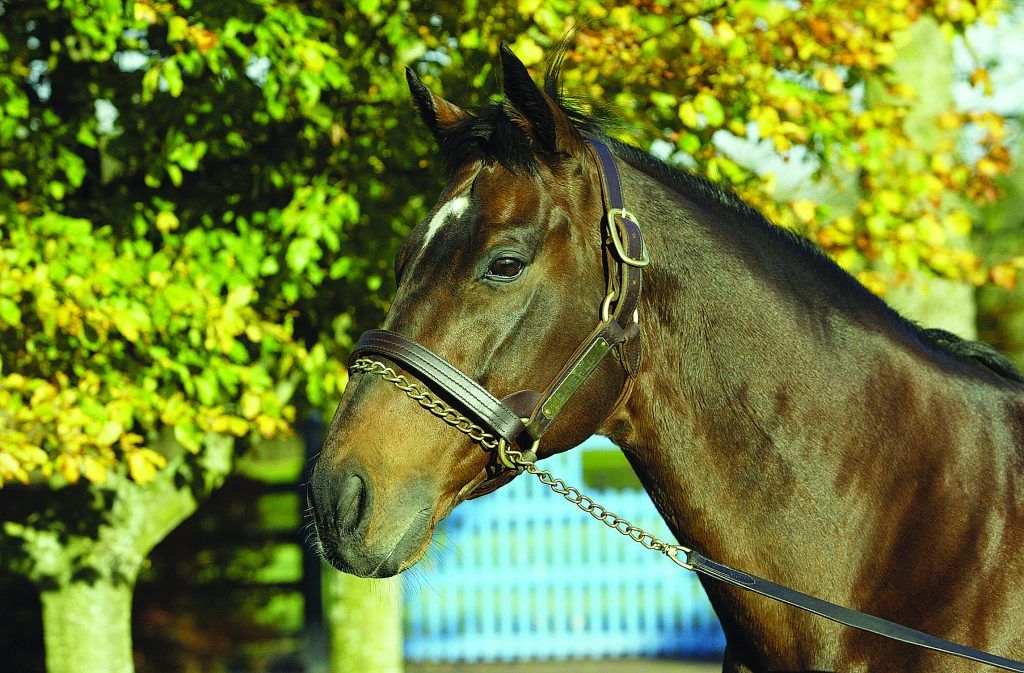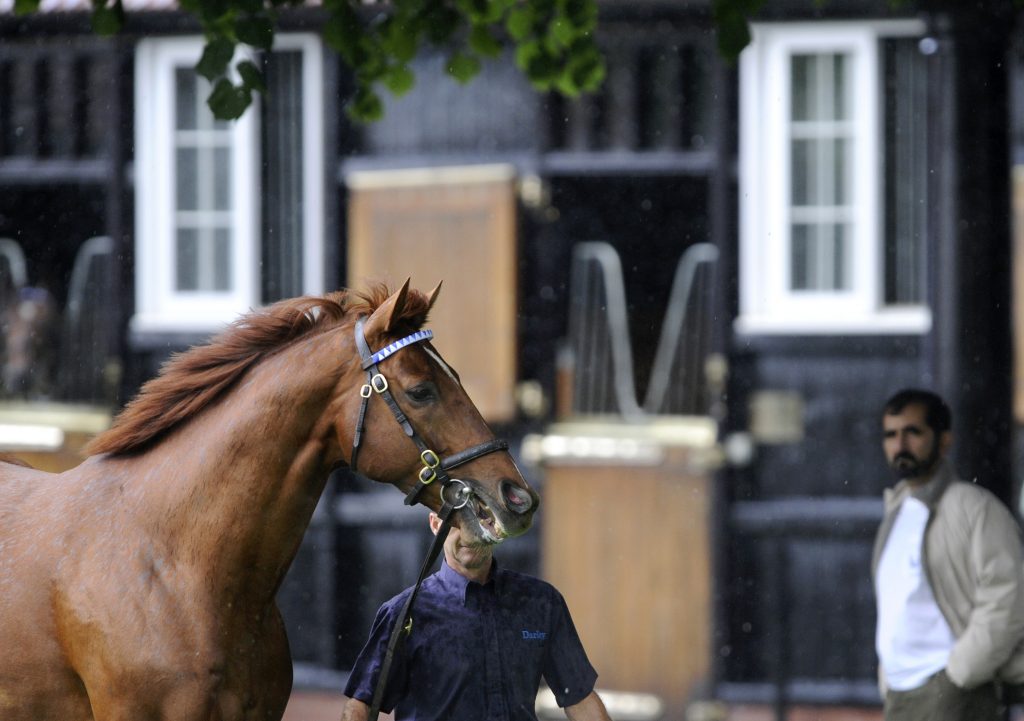The pedigrees of the nine European Classic winners collectively highlight exactly how difficult it can be for stallion owners to maintain the interest of commercial breeders – a section of society who must rank among the most dedicated followers of fashion.
Of course Saxon Warrior’s sire Deep Impact and Forever Together’s sire Galileo are pretty much immune to the whims of fashion, thanks to their status as two of the world’s few elite stallions. Unfortunately, some of the others have been subject to the type of fluctuating demand which almost guarantees that their careers are going to be subject to further peaks and troughs.

Billesdon Brook goes down to post ahead of her 1,000 Guineas victory. Photo: George Selwyn
Billesdon Brook’s eye-opening victory in the 1,000 Guineas came too late for her sire Champs Elysees, as this brother to Dansili had already been transferred to Coolmore’s National Hunt sector. That transfer came after Champs Elysees’ book had soared from 49 mares in 2013 to 155 the following year but then fell back to 105 mares in 2015 and to only 54 in 2016.
My Catch plays a significant role in Camacho’s up-and-down career
Champs Elysees isn’t the only son of Danehill among the Classic sires under review. Although demand for his services at Banstead Manor Stud varied considerably, the fluctuations weren’t as extreme as those suffered by Camacho, another Juddmonte-bred. The Yeomanstown Stud resident is enjoying a memorable time with his three-year-olds of 2018. While the star of the crop is Teppal, who came out best in a tight finish to the Poule d’Essai des Pouliches, it has also produced two other ‘Guineas’ victors, with Another Day Of Sun taking the Spanish equivalent of the 2,000 Guineas and Queen Estoril the Danish version of the 1,000 Guineas.
Arguably much more important than those Spanish and Danish successes were the victory of Camacho’s seven-year-old son My Catch in the Group 3 Al Shindagha Sprint and the success of his two-year-old filly Signora Cabello in a competitive edition of the Queen Mary Stakes.
My Catch plays a significant role in Camacho’s up-and-down career, as he is one of 76 members of Camacho’s 2011 crop (his fifth). This larger crop in 2011 reflected the encouraging start made by his comparatively small first crop in 2009. Although only 43-strong, this first crop produced three black-type juveniles headed by Star Rover (Timeform 103) and Puff (TF 106). Puff’s victory in the Group 3 Fred Darling Stakes was early enough in 2010 to attract more mares. So, instead of the 40 foals in his second crop, 18 foals in his third and 40 in his fourth, Camacho went to war with 79 juveniles in 2013.
These juveniles did particularly well, with Green Door taking the Group 2 Flying Childers Stakes and My Catch the Group 3 Prix de Cabourg, while Ambiance, Beldale Memory and Hurryupharriet all became Listed winners over five furlongs. The problem was that there were no Group winners from his second, third or fourth crops, just a handful of Listed winners, setting the cycle of rise and fall into motion. Camacho had only 20 foals in his 2012 crop, a mere four in 2013 and 30 in 2014, but then the success of his larger 2011 crop saw a considerable revival in interest in Camacho, who possibly also benefited from the impressive start made by his half-brother Showcasing in 2014. The end result was a 2015 crop of 88, of which Teppal is one.
Even though there were no black-type performers from Camacho’s 2012, 2013 and 2014 crops, breeders decided to stick with Camacho in 2015, to the extent that he has more than 100 two-year-olds in 2018 and he covered no fewer than 177 mares in 2016 for a crop of over 140 in 2017, so – at the age of 16 – Camacho has finally received sufficiently prolonged support to get off the rise-and-fall treadmill. That said, his 2017 book fell short of 100 mares.
Danehill dominance
The third son of Danehill to sire a Guineas winner was Holy Roman Emperor. Just as he’d done in 2012, when Homecoming Queen romped home a 25-1 winner of the 1,000 Guineas, Holy Roman Emperor sprang a considerable surprise in the Irish 2,000 Guineas, when Romanised also scored at 25-1. Holy Roman Emperor seems to have been around for ages, partly because he covered his first mares at the age of three, but he is still only 14. He is another whose foal crop dwindled a little in recent years, going from 132 in 2014, to 104 in 2015 and 75 in 2016, and his 2017 crop is also much smaller than his biggest crop, which numbered 155 foals in 2009. It mustn’t be forgotten, though, that he has shuttled to Australia in 2015, 2016 and 2017, covering as many as 127 mares in 2016 and 99 in 2017, so he has been busy enough.
The domination of the Danehill male line in this year’s Guineas races continued when Alpha Centauri turned in a career-best effort to land the Irish 1,000 Guineas. The subsequent Coronation Stakes winner is by Mastercraftsman, himself a son of Danehill Dancer, a stallion who has enjoyed Classic success with his daughters Speciosa, Legatissimo, Again and Dancing Rain.
Mastercraftsman is another example of a stallion who enjoys a particularly good season every four or five years, which is roughly the time it takes for the success of one crop to be translated into another.

Danehill: The domination of his line in this year’s Guineas races continued with Alpha Centauri. Photo: Trevor Jones
The 2009 Irish 2,000 Guineas winner made a fast start at stud with a first crop numbering 135 foals. Mastercraftsman duly became 2013’s leading first-crop sire, thanks to the Group successes of Kingston Hill (Racing Post Trophy), Amazing Maria and Craftsman. This first crop did even better at three in 2014, when The Grey Gatsby won the Dante Stakes and Prix du Jockey Club and Kingston Hill finished second in the Derby before going on to St Leger glory. There was also an Italian Classic success, when the filly Vague Nouvelle took the Premio Regina Elena.
These results presented Mastercraftsman with every chance of shining again with his 2015 and 2016 crops, the former sired at an increased fee of €35,000 and the latter at €40,000. Mastercraftsman’s 2015 crop was not only his most expensive up to that point but also his largest at 174 and his 2016 crop numbers 130. In addition to Alpha Centauri, the 2015 crop includes Wind Chimes, an unbeaten two-year-old who was a close third in the Poule d’Essai des Pouliches.
However, there were a few comparatively fallow years in between those Classic-winning seasons in 2014 and 2018. With his second and third crops both being smaller than the first, at 114 and 98 foals, neither has come close to matching the first crop’s excellent totals of ten Group winners headed by three Group 1 winners. There were just two Group winners in his 2012 crop, five in the 2013 crop (but no Group 1 winners) and just one Group winner so far in his large 2014 crop (which was sired at a reduced fee of €12,500).
A second downturn in Mastercraftsman’s career may already have been set in motion, as his 2016 and 2017 books stood at 104 and 108 mares and his fee was back down to €25,000 by 2017.
American switch
It will also be interesting to see how the career of Declaration Of War develops. Although he has the Poule d’Essai des Poulains winner Olmedo in his first crop, the picture has been somewhat clouded by the decision to move the son of War Front to the US, after just one season in Ireland. The move was motivated by the fact that Declaration Of War finished a close third in the Breeders’ Cup Classic on dirt after the decision had been made to base this winner of the Queen Anne Stakes and the Juddmonte International in Ireland.
Young American-based stallions frequently find support steadily ebbing away from them over their first four seasons and Declaration Of War’s first three years at Ashford Stud have seen him cover 192, 154 and 128 mares. While a book of 128 mares is more than enough to help a stallion prove himself, it is still only two-thirds as big as Declaration Of War’s first American book. In other words, that third American crop may one day pale in comparison with the first, simply because not enough attention is paid to crop size and percentages.
The last Classic stallion on a roller-coaster ride is New Approach, who represents the bridge between Galileo and Masar in this impressive trio of Derby winners. Needless to say, New Approach began his stallion career in a blaze of glory, with the future 2,000 Guineas winner Dawn Approach among his three juvenile stakes winners at the 2012 Royal Ascot meeting. Bearing in mind that that first crop also produced the Oaks winner Talent and the Derby runner-up Libertarian, New Approach could hardly have made a better start and this first crop ultimately produced eight Group winners, including three at Group 1 level.
As the champion colt of his generation at both two and three, New Approach appeared to be perfectly placed to follow in the footsteps of his sire Galileo. His fee quickly rose, to £50,000 in 2013 and to £80,000 in 2014 and 2015, which seemed likely to guarantee him even better mares.
Young American-based stallions frequently find support steadily ebbing away
However, the fact that his fee was back down to £30,000 by 2017 tells its own story. Although there were two Group 1 winners among the four Group winners in his second crop, these two – Potemkin and Elliptique – didn’t gain that status until they were five in 2016. Crops number three and four have produced just three Group winners between them, none at Group 1 level, but they can be partially excused because they were sired at a reduced fee of £22,500. The £50,000 2014 crop has also fallen below expected standards, its only Group winner so far being the Group 2-winning filly Strathspey. However, we have another example here of Classic success being repeated five years down the line, with Masar emerging from New Approach’s first £80,000 crop to win the Derby.

New Approach: is the latest Classic stallion on a roller-coaster ride. Photo: George Selwyn
As his progeny have now won the 2,000 Guineas, Oaks and Derby, New Approach has clearly earned further first-rate opportunities but his crop size has been falling – no doubt partly because he is a rig who needs careful management during the breeding season.
All in all, these stories appear to add up to one of success breeding further success. Spare a thought, though, for these stallions when things aren’t going so well – a sire can’t be a good stallion one year and not worthy of support the next. Commercially it could pay not to join the rush to pay top dollar to access the in-vogue stallions, but to support him a year or two later, so that your youngster arrives at the sales at a time when the stallion’s progeny are again excelling on the racecourse.


